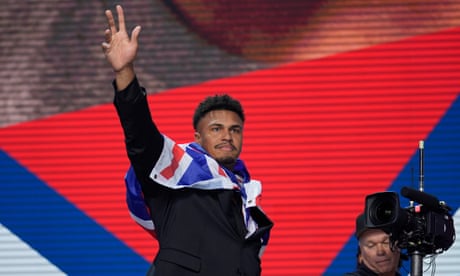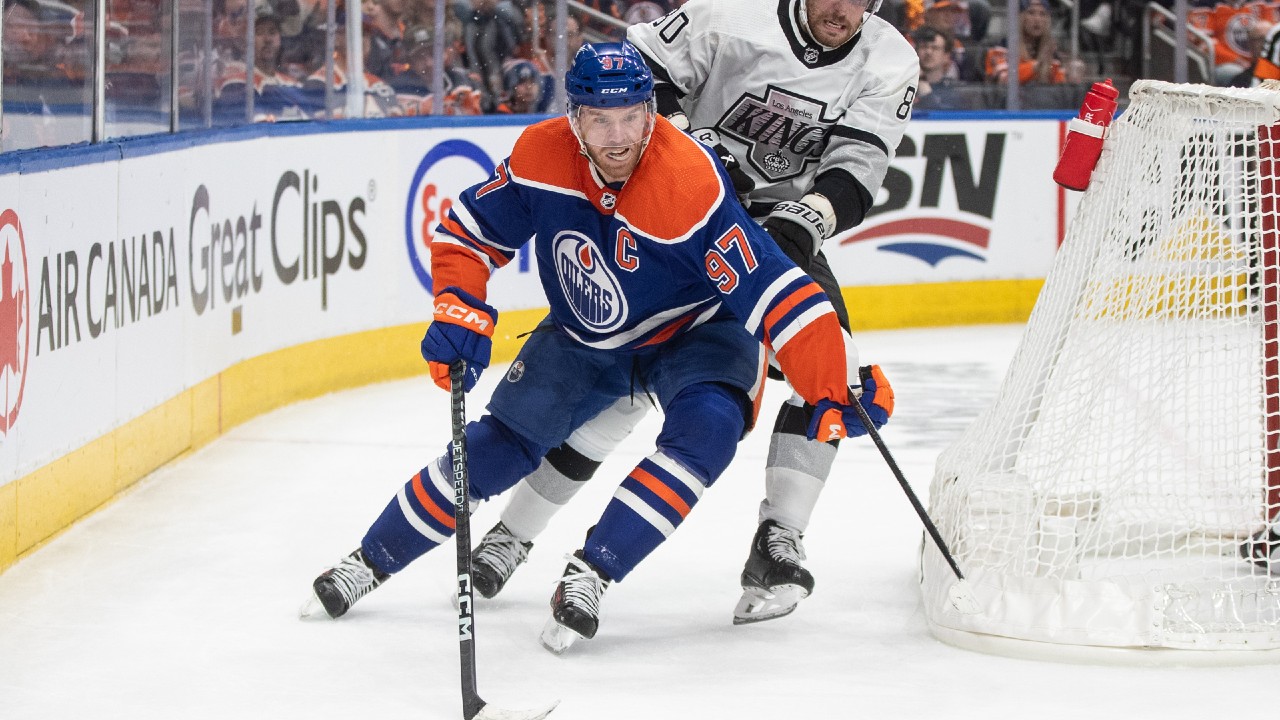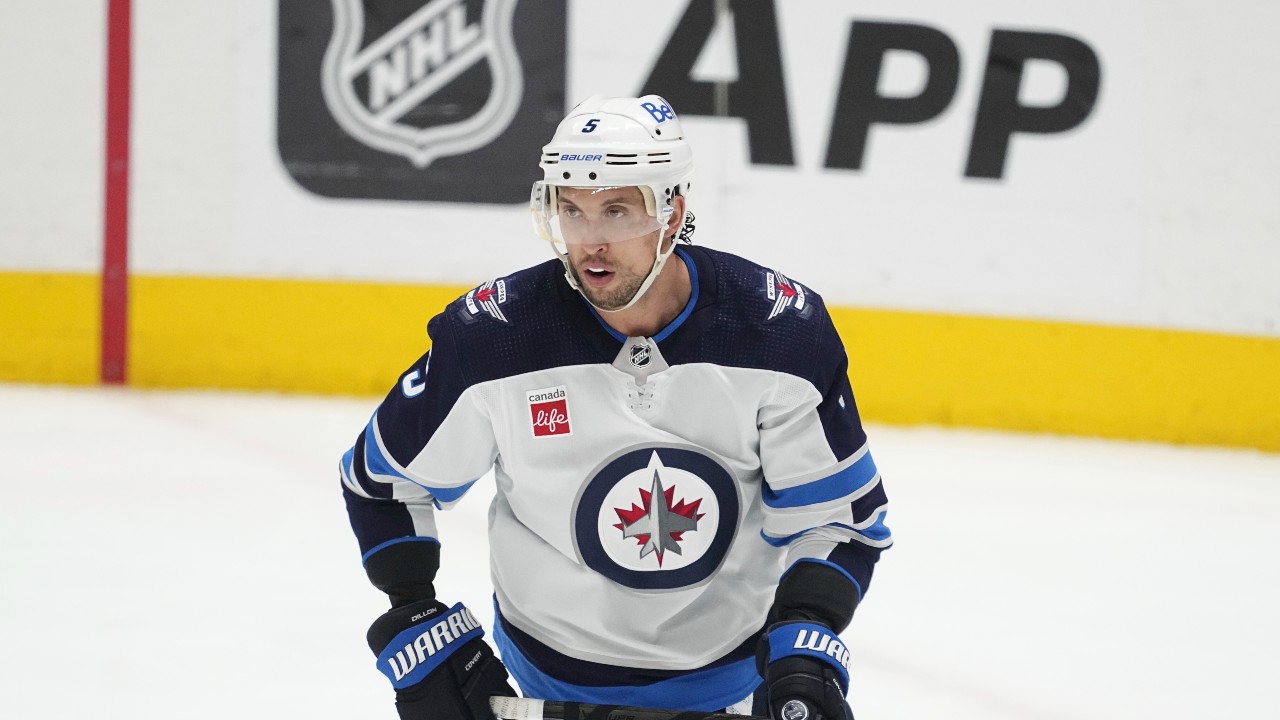
“HE DEFINITELY LEFT HIS MARK ON THIS CITY”
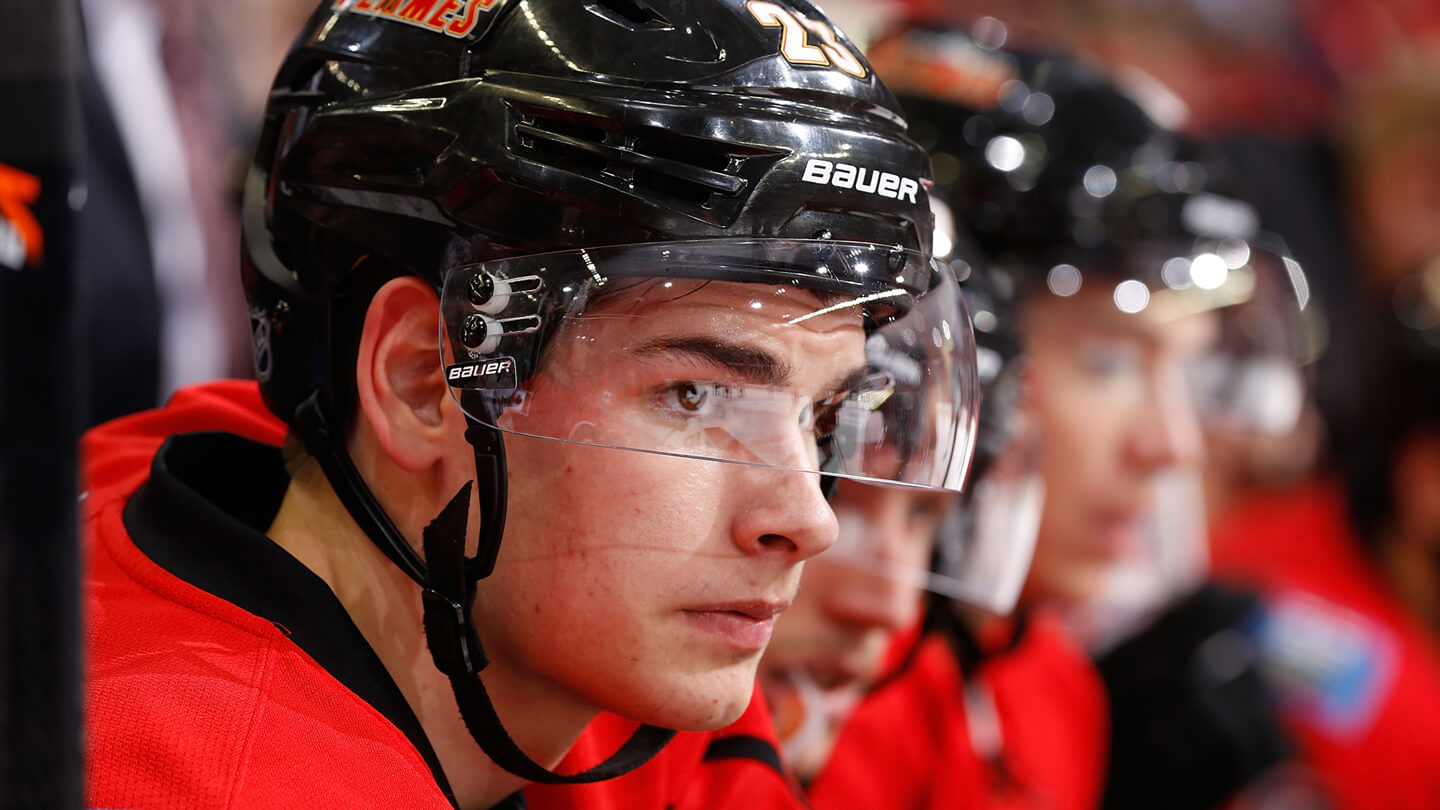
F
or those outside the city of Calgary, there’s one name synonymous with the past decade of Flames hockey: Johnny Gaudreau.
But for the locals — those who’ve sat in the Saddledome nosebleeds and swapped Red Mile stories at the Varsity ODR; those who remember when Melrose was still Melrose — before Johnny, there was Mony.
Walk through the Dome on game night, gaze up into the ‘C of Red,’ and you’ll spot as many No. 23’s as 13’s on the backs of the jerseys milling about. You’ll hear as many stories of marquee Mony game-winners from the good old days as ones about those potted by his star linemate. Because while the wider hockey world might only have ever seen Sean Monahan as the stoic sidekick to the high-flying Gaudreau, in the city in which he made his name, Monahan meant so much more.
To understand why, you have to flip back through the pages of the Flames’ story, back before Gaudreau, before Sam Bennett and Matthew Tkachuk. Back to 2013-14, when the city was still figuring out how to navigate life without its beloved franchise legend. There was no sense then of the revival that would come, of the youth movement that would take hold. There was just a No. 12-shaped hole in the locker room, and a kid named Sean.
This is the story of how Monahan helped fill that void, how he made his name and won over a city, as told by those who were right there with him as he did it.
After nearly two decades in a Flames sweater, the final 10 years with the ‘C’ stitched to his chest, a 2013 trade to Pittsburgh put an end to Jarome Iginla’s iconic run in Calgary. In his absence, the city found itself preparing for a new season unsure what exactly the Flames would look like without No. 12 leading the way.
CRAIG CONROY, Former Flames player, current Flames assistant GM: It was weird. ‘Uncertainty’ really would be the word I’d use, because, just, people didn’t know what to expect. They weren’t quite sure. Jarome was here for so long and he was really the focal point, him and Kipper [Miikka Kiprusoff].
MATT STAJAN, Flames forward, 2009-18: It was definitely a change. Bob Hartley came in, Jarome had left, Alex Tanguay had left.
MARK GIORDANO, Flames defenceman, 2004-21: Iggy, Kipper, Jay Bouwmeester — a bunch of guys moved on.
STAJAN: It was kind of a new era for the Flames.
LANCE BOUMA, Flames forward, 2010-17: It was different. It was a big change for Calgary, definitely, not having Jarome around. We were younger guys at that time.
TJ BRODIE, Flames defenceman, 2010-20: It was one of those years that you didn’t really know what to expect.
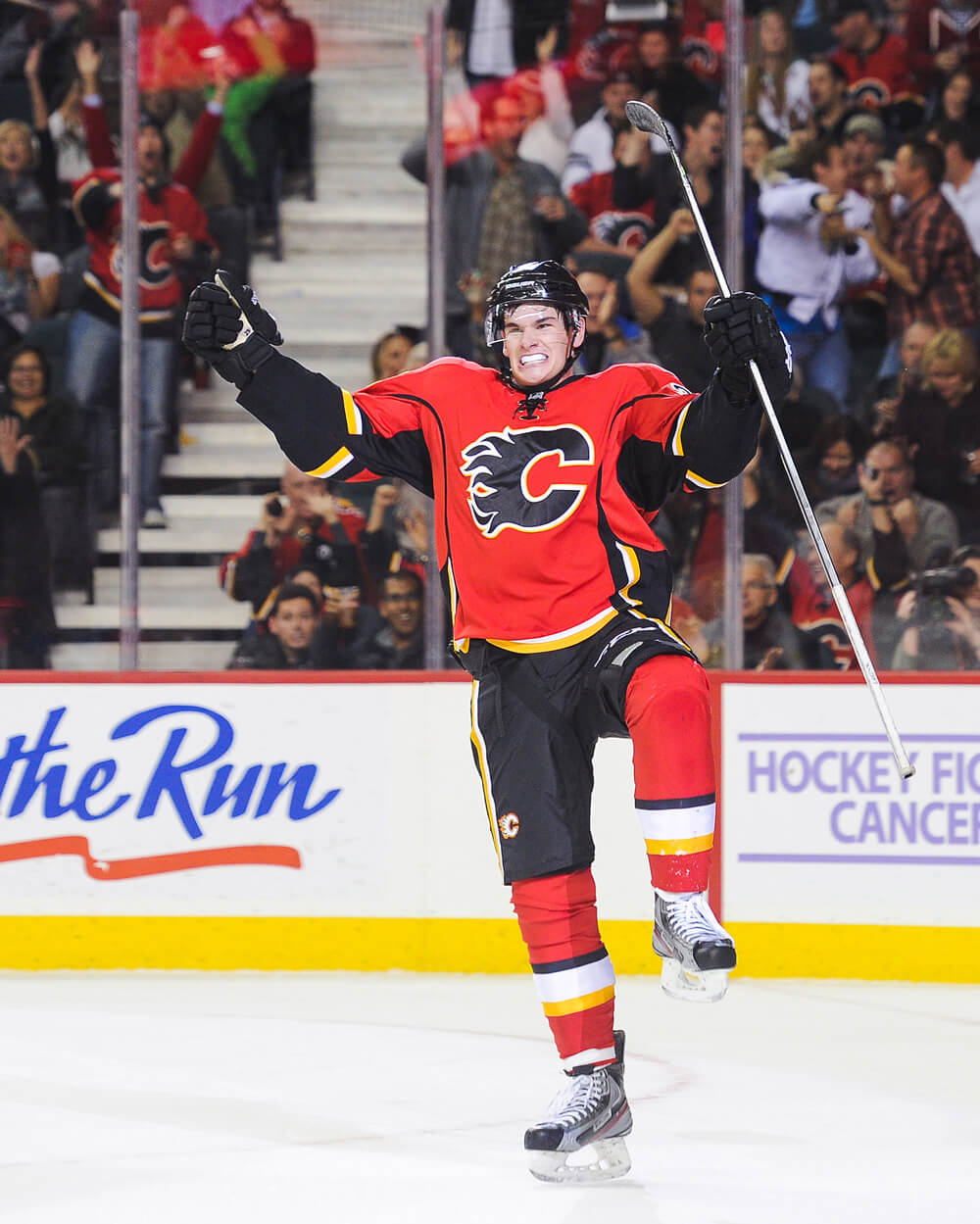
With the sixth-overall pick in the 2013 NHL Draft, the Flames selected Monahan from the OHL’s Ottawa 67’s. As preparations began for that 2013-14 season, the teenager arrived in Calgary for his first big-league training camp — and never looked back.
GIORDANO: Mony came into camp — at the start of camp, [the plan was]he was going back to junior for sure. And he didn’t give them a choice, because he played so well.
CONROY: The thing that surprised me — you know, I watched Jarome, got to pass Jarome a lot of pucks, and see his shot. But Mony’s shot was elite already. And you thought, ‘I wonder if it’s going to translate into scoring goals in the NHL.’ You know, just the way he was able to hide the puck, and then his release — in practice, if he took 10 shots, eight of them went in.
I didn’t know if it was going to work [in games], and then the season started. He had an assist the first game, and then he started scoring the goals. He just played. He had six goals in the first nine games. [Laughs.] He played so well that we couldn’t send him back — even if we wanted to send him back, we just couldn’t.
STAJAN: He could put the puck in the net, that’s the main thing. That’s the hardest thing to do in the NHL, is score goals, and he was able to right from the start. He just had the ability to beat goalies. He has a sneaky shot, [and it’s]accurate.
GIORDANO: You give him a puck around the net, he has an unbelievable first touch and unbelievable poise around the net to put it in. He just has that knack, and he’s always been like that.
CONROY: He just proved to everybody, ‘Hey, you know what? I’m here. I know Jarome’s gone, but I’m going to pick up some of that goalscoring.’ If there was any key moment where we needed a big goal — in overtime, in the shootout — it just seemed like he was able to find a way.
STAJAN: I know the ‘Boring Sean Monahan’ thing took off, but he just kind of went about his business. It didn’t matter what the moment was, no pressure got to him. And he was just able to score timely goals for us. You look at his overtime goals and his shootout goals and his percentages, how much success he had, it speaks for itself.
BRODIE: He’s just clutch, you know? You knew that if he got a chance, and the game was on the line, there was a good chance he was going to put it in.
STAJAN: He deserves a lot of credit. Because he came in and nothing was given to him. He earned it that first training camp. There was no guarantee he was going to stay, and he earned that spot, and he quickly established himself as our No. 1 centre.
CONROY: That first 10 games, all anybody talked about was the nine games — ‘Is he going to get sent back? Is he going to get sent back?’ I remember, you’d talk to him and, like, he didn’t think for one second he was going back. Just that confidence and the belief in himself, I think that rubbed off on everybody around him.
BOUMA: As a young rookie, coming in and doing that kind of stuff, it was just pretty impressive to see. He didn’t really get nervous about the pressure or anything like that. He just came in and did his job, and did a great job.
CONROY: Sean started scoring goals and, you know, being the sixth-overall pick, everyone’s like, ‘Whoa. We might be okay.’ I think it went from uncertainty to real optimism that, ‘You know what, we got a good young player here, and maybe this isn’t going to take as long as people thought.’
When you lose the greatest player in the franchise’s history, you’re definitely restarting a little bit. We wanted to do it on the fly, and Sean really kind of jumpstarted that, and got the fans excited. That was the start of the new era of Calgary Flames hockey.
While the 19-year-old was quickly proving to be a force on the ice, tearing it up from Day 1, his persona off the ice wasn’t quite as flashy. Ask those who were there at the time about their first impression of a young Monahan, and the off-ice scouting report rings fairly consistent.
BRODIE: He was a pretty quiet guy, laid back.
STAJAN: He was quiet. He was very respectful.
BOUMA: A quiet guy, but we hit it off pretty quick.
GIORDANO: Quiet. Really confident, but really just a quiet presence about him.
CONROY: He was very, very quiet at the time. But when he was on the ice, you know, that’s where he did his talking.
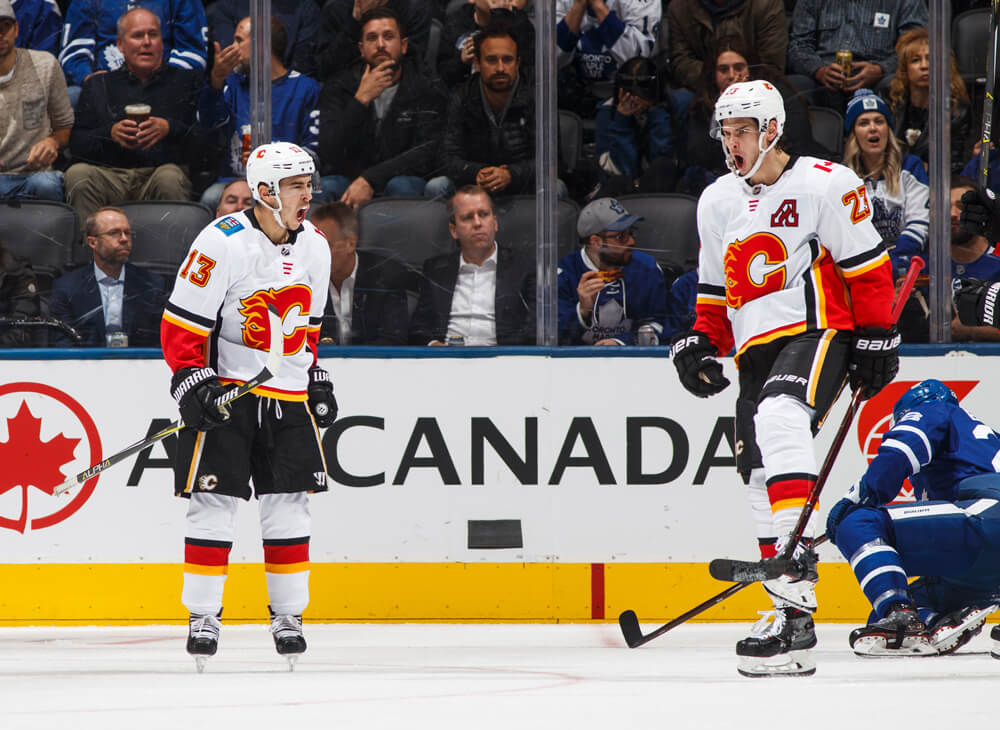
STAJAN: Once you get to know him, and get to see his personality, he’s a pretty funny guy.
BOUMA: It’s that dry sense of humour. Easy to get along with, easy to talk with, and obviously a great player right from the start.
CONROY: He was one of the guys we brought in and had lunch with prior to the draft — we just had a feeling. Picking sixth overall, he was one of the guys in that area. I remember just how easy it was to talk to him — for a young guy, he was already mature at that age. It was amazing how he was just such a professional.
BOUMA: He was a top pick, so people expected a lot out of him, and he just came in and played great right from the start. And, you know, he just rode that out throughout the entire year. Obviously, as a rookie, there were bumps in the road along the way, but he did a really good job of just sticking with it and having confidence in himself, even as a young player.
STAJAN: He’s just Sean. You know, Mony’s a guy that just goes with the flow. He’s pretty laid back, but he cares a lot. When you have the spotlight on you, a lot of pressure on you, and you just go about your business, that’s what he did. He’s a proud guy, so he puts in the work. And he also knows how to keep the mental side flowing in the right direction — he doesn’t get down on himself, he doesn’t get too high on himself, he just goes about his business. That’s why he was successful at such a young age.
BRODIE: You know, I think for him, he’s just so down to earth and laid back that he just goes with the flow. And I think, as a team, we were sort of considered underdogs. So we had that extra push to kind of try to prove people wrong. It was just one of those years where we had a lot of comebacks and things like that, and guys gained confidence over the year.
STAJAN: You could feel in the city that they were kind of doing a retool, a little bit of a rebuild, and there was a lot of excitement about young guys. That’s what happens when you lose your superstar — you look for who’s going to be the next one. Those young guys came in and, you know, there was a spotlight right away.
And Mony was the first one.
Monahan might’ve been first — the one burdened with bridging the gap between the Iginla era and what came after — but in his sophomore season, he got reinforcements in the form of a rookie Gaudreau. And from there, one of the franchise’s all-time duos was born.
CONROY: Him and Johnny were at the development camp together in the summer, and they got put together on a line — it was, like, instant chemistry. Johnny was feeding Mony, Mony’s scoring goals, and you’re like, ‘Oh, this might work one day.’ [Laughs.] It’s almost like they were playing together for 10 years prior.
[After that camp] John went back to school, Mony started playing in the NHL. When they got back together [in 2014], that whole year, you were like, ‘Whoa.’
STAJAN: It was amazing to watch how quickly it happened. Johnny’s rookie year was Mony’s second — they took off, with Jiri Hudler. It was just chemistry that was instant, and it was there all year. Straight to playoffs, straight to the last game. It was amazing to watch two young kids do that.
CONROY: They were so good, him and Johnny, in the overtimes, especially early on. It just felt like anytime you put them on the ice, it was game over. You felt like it was an automatic win. And if we had to go to a shootout, it was that elite shot and just the confidence that he wanted to be out there.
That’s what I liked, you know? Sometimes guys don’t want to go out there for the shootout, the pressure. But [Monahan] really wanted to be that guy. He wanted that pressure. He wanted the puck on his stick in key moments.
BRODIE: They complemented each other well. Mony’s a shooter; Johnny, he can score, but he opens up the space and makes the plays. Together, they were a tough tandem to stop.
STAJAN: Johnny, he’s such a playmaker and makes things happen, and Mony knows where to go on the ice, he finds the soft spots. If you’re a playmaker and you have a player that knows where to go, and you read off each other, you can put the puck in the back of the net. It’s going to work. And that’s what happened.
CONROY: Every time they got on the ice, you thought they might do something special, you know? Everybody in their seats, in the stands, when they were both on and they were on a rush or they were doing something, you just felt like they were going to do something. And it just it brought the whole city back, it really did.
And then, as the chemistry on the ice grew, I think the friendship off the ice grew. You know, you would go to a pre-game meal and they’d be together — they were always together, everywhere they went. If you saw Mony, you saw Johnny. It was always the two of them.
BOUMA: They were great friends. We had a tight-knit group every year I was in Calgary and a lot of that was from everyone just getting along. And you know, Johnny and Mony, they didn’t think they were too big for anyone. They wanted to get along with everyone. They were exciting to watch, and it was just cool, because they were such good guys off the ice, too.
CONROY: They became the best of friends. They had that chemistry on the ice, they had that chemistry off the ice. They genuinely just really, really liked each other. When Sean was hurt last year during the playoffs [and underwent season-ending hip surgery], when John scored the winner in Game 7 [against Dallas], he came off and gave Sean a hug — it was so fitting. Those two. It just made me think back. It was special.
After a run that saw Monahan post seven seasons above the 20-goal plateau, three above the 30-goal mark, and help lead the Flames back to playoff relevancy, injuries began hampering his ability to contribute as he once had. In August, the Flames traded the centreman to Montreal, offering him a chance for a fresh start after a decade in Calgary.
CONROY: You know, I think as he kind of grew up here, he was always a guy who was relied upon and had the pressure to have success. But he took it in stride and he always did well. He did have some injuries a little bit later on and he never complained, he never made excuses. I mean, people don’t really know what he was battling through at times. But that was part of him being the leader that he is. He didn’t want to try to make excuses. You know what, he just went out and tried to do his best and help the team.
GIORDANO: Oh my God, we have so many memories. I would say more off-ice memories — Christmas parties, just hanging out a lot. The overtime ones stand out on the ice. And just going through some battles with him in the playoffs, stuff like that. He’s a great dude, man. He’s one of the good guys in the game. I know the past couple of years haven’t gone as smoothly as possible, but he’s had some big, big surgeries and some big injuries.
CONROY: I think of him always coming to the rink excited, looking forward to playing. He put the jersey on with pride. He was just proud to be a Calgary Flame.
BOUMA: We lived together, too, so we had a lot of great memories together, him and I. We’re good friends still to this day. He’s someone that I still talk to all the time, almost weekly. He’s just a great guy to know. He’s a good friend. You know he’s got your back — whenever you need something, he’ll be there to talk to you, or just joke around about old times.
BRODIE: We spent a lot of time together — we lived on the same street, so there were lots of nights where we’d walk to each other’s house after a game and hang out. He’s just a great guy off the ice.
CONROY: Even when I talked to him when we traded him to Montreal, he was the same. I mean, I was a little nervous calling him — you feel bad, because you’ve grown so close to these guys. And he was great. He was like, ‘Hey, I understand, Craig. I love the city, love all you guys. I wish everybody the best. But I think this is the best thing for me, too.’ I mean, that’s just the professional that he is.
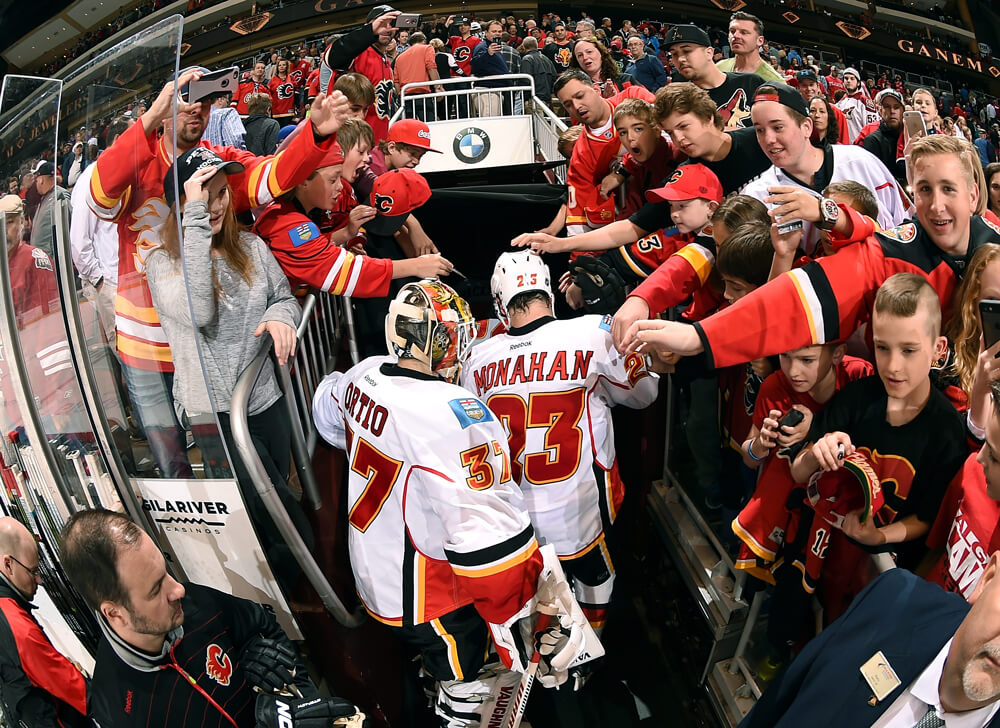
While those outside of Calgary might not fully understand just how important Monahan was to the Flames and their fans, among those who’ve worn that flaming ‘C’ on their chest, there’s no questioning the importance of No. 23’s legacy.
CONROY: He’s one of the greats of all time, in my opinion. I played with a lot of guys here, and then on the management side. He’s one of those guys that kept the franchise going. He made it exciting to be a Calgary Flames fan. The city will never be able to thank him enough. But I do think when he comes back, he’s going to be one of those guys that is going to get a huge cheer. People appreciate what he did for the team, and they know all the stuff he went through.
GIORDANO: He gave a lot to the organization. I think, on and off the ice, he was a guy that the fans really, really enjoyed watching. He was a great guy in the community and around Calgary. I’m sure he’s going to get a great reception there when he goes back, and it’s well-deserved. He’s an awesome person. He deserves everything.
BRODIE: He was there for a long time, and he scored some big goals — he still has the record for the most overtime winners. That was the turning point after Jarome left. So, I think he’ll be well-received.
BOUMA: He’s a huge part of the team and the city of Calgary. He was a great player for Calgary for many, many years. I know the last year was kind of tough for him, but before that, he was the guy there. Him and Johnny; they were the guys. So he’s obviously very important. And I think it’ll be fun, it’ll be exciting for him to return and see all the old faces.
CONROY: When we lost Jarome, everyone was a little bit down in the city, because, I mean, the goal was for Jarome to win a Stanley Cup here in Calgary — it didn’t work. When he moved on, it was like, ‘Well, how long is this going to take? Is this going to be a 10-year thing? Who knows?’ But I think with Sean coming in, it gave everybody the hope that, you know what, this isn’t going to be as long as we thought. We’re going to get back to the playoffs sooner than later.
And sure enough, with John coming, and with Matthew, and Bennett, it just seemed to take off from there. What was nice for us is we were able to find that guy to lead the way. He was the first piece of the puzzle. He really was.
STAJAN: He was a fan favourite here. You go to games and you still see Monahan jerseys everywhere. He really established himself here — he was very involved in the city, donating his time to charities. It was his home for close to 10 years. He was loved here.
And, you know, the business of hockey, sometimes things happen, change happens, and he moves on. But he definitely left his mark on this city.
Gerry Thomas/NHL via Getty Images; Derek Leung/Getty Images; Mark Blinch/NHLI via Getty Images; Norm Hall/NHLI via Getty Images.


